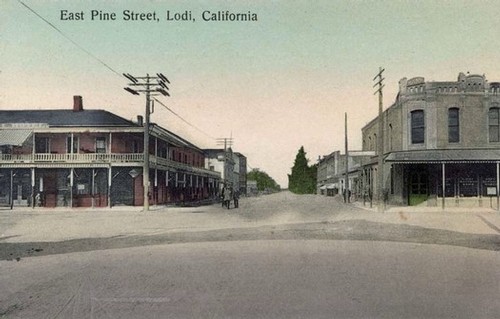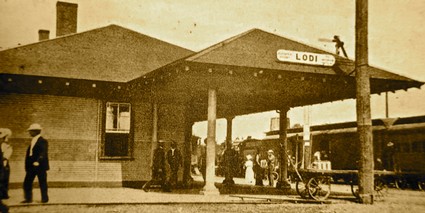Letters from Lodi
An insightful and objective look at viticulture and winemaking from the Lodi
Appellation and the growers and vintners behind these crafts. Told from the
perspective of multi-award winning wine journalist, Randy Caparoso.
Story of an appellation—Part 7, Lodi's iconic Mission Arch

Lodi's iconic Mission Arch in November.
Continued from Story of an appellation—Part 6, the indelible impact of Lodi's German community
"If grapes are the pride of Lodi," writes Ralph A. Clark in Lodi, Images of America, "then the Lodi Arch [often called Lodi's Mission Arch] is its iconic symbol. The monument is the most recognized piece of architecture in the city, and its unique design inspires many residents, both old and new."
Hence, this symbol has given the City of Lodi a recognizable identity as a historic California destination. It is not an ancient destination.

1887 postcard of the intersection of Lodi's unpaved Pine and Sacramento Streets, 20 years before Lodi Arch would go up on this site; the Lodi Hotel to the left, which would be torn down in 1912 and replaced with the Bank of Lodi building (a brick structure still standing today).
A brief summary of the city's history:
• The first settlers arrived at the end of the 1840s, at the same time as forty-niners and California statehood (September 9. 1850).
• The settlement was originally known as Mokelumne—the Native American name for the river that winds through the surrounding agricultural region—and officially changed to Lodi in 1874.

The Lodi train depot in 1869, the establishment of which jump-started the growth of the settlement of Mokelumne, which would be renamed Lodi in 1874.
• Mokelumne/Lodi did not exist as a significant entity until August 1869, when Central Pacific Railroad was enticed by a group of local businessmen to establish a railroad depot on 12 acres of gifted land along Sacramento Street, just south of Pine Street. Immediately thereafter, surrounding streets were surveyed and mapped out, leading to an almost instantaneous establishment of businesses (stores, hotels, banks, saloons, etc.) and homes (56 new ones within the first year).
• Lodi citizens voted to incorporate as a city in 1906, taking most of its governing out of the hands of San Joaquin County.

Lodi in 1907—a view of Sacramento St. looking north from Oak Street, the newly erected Lodi Arch and wagons (in front of the unseen train depot) to the right, and Central California Traction rails running down the street. Ralph Lea, Lodi Historical Society.
Hence, 1907 was an auspicious time for the newly minted City of Lodi. According to the Lodi Historical Society's Lodi Historian newsletter (Fall 1990):
The grape had replaced the watermelon. The town had just become incorporated the year before. Tracks for a new passenger railroad were being laid between Stockton and the 2,000 inhabitants of this proud city. It was spring and the disastrous flood of 1907 had receded...
Charles Ray [a local businessman] put forth the idea of advertising the beauty and value of the Tokay grape by having a large carnival which would make the entire central portion of the state, if not the world, sit up and take notice...

Mid-1907 photograph of the Lodi Arch—and behind it (to the west, on Pine Street), the wooden "fun arch"—under construction in preparation for Lodi's September 19-21 Tokay Carnival. California State Library.
Thus, in the spring of 1907 Lodi citizens swiftly mobilized to put on what was to be the first and only, nonetheless never-to-be-forgotten, Tokay Carnival. The celebration was to last three entire days—September 19 through 21.
Never mind that these dates fell in the middle of harvest. This was precisely the plan. The third week of September was chosen specifically because that would be when Tokay grapes were fully ripened and ready to be shown off in a procession of horse-drawn carts—as it turned out, a parade over a mile long—into the city and through no less than two triumphant arches, erected just for the occasion just a few away from the railroad depot.

At the opening of the 1907 Tokay Carnival, "Queen Zinfandel" and her Royal Court being pulled by white horses under the Lodi Arch; followed by a procession of carts laden with Flame Tokay grapes, over a mile long. Lodi Historical Society.
The carnival planning committee decided that the procession—which would also include a "Queen Zinfandel" accompanied by a Royal Court—should enter under two arches: the Mission Revival-inspired “Lodi Arch” that still stands today, and a temporary wooden “fun arch” containing a bandstand and two theaters, topped by castle-like battlements, waving flags and banners proclaiming the "History of the Grape."
Mission Revival architecture, as the name implies, is inspired by Spanish missions built between Baja California and the Bay Area between 1769 and 1833. Not coincidentally, during that time the dozens of Plains Miwok tribes that occupied the area known today as Lodi—originally a flat expanse of oaks, grasslands, and marshy riparian habitats—were decimated by the end of the Mission era.

1907 commemorative postcard of the Lodi Arch looking eastwards across the Central California Traction tracks (transporting passenger cars traveling between Stockton and Sacramento), still a few years before it gets its "Lodi" lettering and golden bear.
Lodi, that is to say, was never a Spanish outpost in and of itself.
All the same, the design of the arch meant to serve as the centerpiece of the 1907 Tokay Carnival was submitted by Stockton architect E.B. Brown and was inspired by California's Mission Revival architecture. City planners were so impressed, that they decided to build it as a permanent structure; albeit, according to Clark, "out of wood, metal lathe, and cement by Lodi builders Edward and Fred Cary for a cost of about $500.

1907 photograph of Lodi Arch with Central Pacific Railroad cars arriving at the train depot, just a few feet away to the south. Center for Sacramento History.
Adds Clark:
By 1910, the city had added its name, complete with electric lights, to the icon. But the most enduring addition came in 1909 when the Lodi Parlor of the Native Sons of the Golden West stole a large papier-mâché bear from an Admission Day parade float designed by the neighboring Stockton Parlor of Native Sons. The bear was placed on top of the arch facing towards Stockton as a practical joke and has been a much-loved addition ever since.
By 1955, the arch was neglected and had fallen into disrepair. The Lodi City Council declared it a safety hazard and threatened to demolish the monument. Thankfully the arch was saved by the very group it had come to symbolize, Lodi's citizens.

1909 photo of Lodi's Mission Arch from the corner of Sacramento and Pine, showing the muddy, unpaved streets. Lodi News-Sentinel.
In 1981, the arch was added to the register of California Historical Landmarks as No 931. In 1980 the Lodi Arch was added to the National Park Service's National Register of Historic Places as #80000848.

Colorized 2010 postcard photo of Lodi's Mission Arch, evidently taken from the second floor of the Lodi Hotel.
A couple of things about the golden bear that famously walks atop Lodi's emblematic arch:
• For 47 years, the bear faced south—its ample posterior, or so the lore of old-timers goes, turned toward Sacramento as a way of expressing discontent with the state government. In 1956 the bear was turned in a more respectful direction northwards, following a layering of plaster.
• The bear did not take on its familiar golden sheen until 1938 after it was given significant repairs and gilded with gold leaf by city employee Clair F. Schultz. For a short time, following further repairs in 1961, the bear was painted brown (to the consternation of many locals), with some gold highlights. Its golden coat was restored in 2002 by Lodi artist Tony Segale, a master in the art of 23.7-carat gold leaf layering.

1911 photograph of Lodi's Mission Arch, with a California golden bear (originally a paper-mâché figure placed atop the arch the year before as a prank) making its appearance. Note: California golden bears became extinct in 1922. Lodi News-Sentinel.
Exposed to all the elements, however, a bear sitting atop a 40-ft. arch for well over 100 years old is bound to suffer immense damage. Despite Segale's work in 2002, by 2023 it had already sustained further gaping holes, requiring its temporary removal for complete reconstruction and additional layers of gold leaf by Segale. A completely refurbished golden bear, now weighing over 500 pounds, was finally placed back onto the arch this past September.
Long live Lodi and its historic Lodi Arch!
More photos of Lodi's Mission Arch taken through the years:

1915 photograph of a Christmas tree in the middle of Pine Street on the east side of the Lodi Arch. Ralph Lea, Lodi Historical Society.

1918 photograph of Lodi Arch, now with its "Lodi" signage, its bear facing south towards Stockton, and a "For 100% Americans" banner placed by Lodi's German community to demonstrate their allegiance to the U.S.A. during World War I. Lodi Historical Society.

1936 celebration of Lodi-grown wines and the Flame Tokay grape at the first Lodi Grape Festival, under the city's historic Lodi Arch.

The Lodi Arch in 1967, with a brown-colored bear facing north (its direction since 1956), towards Sacramento.

2001 photo of the Lodi Arch bear, brown colored and in serious disrepair; the following year (2002), the bear was removed, repaired, and layered with 23.7-carat gold leaf by local artist Tony Segale. Lodi News-Sentinel.

Recent photo of lights being replaced under the Lodi Arch. Lodi News-Sentinel.

2004—changing of lights on the Lodi Arch's lettering to Christmas colors. Lodi News-Sentinel.

In 2012, the Lodi Arch still has a classic vintage look, emblematic of a historic California and American town.
2019 photograph of Lodi's historic Mission Arch in holiday colors.

In September of this year (2023), a completely refurbished golden bear, now weighing over 500 pounds, is placed back atop the Lodi Arch. Lodi News-Sentinel.

Lodi growers and vintners enjoying a 2015 dinner on Pine Street under the historic Lodi Arch.
